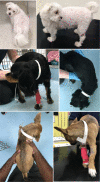The value of a head turn in neurolocalization
- PMID: 38158778
- PMCID: PMC10800234
- DOI: 10.1111/jvim.16957
The value of a head turn in neurolocalization
Abstract
Background: A head turn is a clinically relevant abnormality identified on neurological examination and historically has been an isolated or concomitant sign of ipsilateral forebrain dysfunction. Experimental studies in quadrupedal mammals suggest that changes in head posture may be identified as originating in other parts of the central nervous system (CNS).
Objectives: To identify whether other locations within the CNS could give rise to a head turn and whether the head turn identified is isolated or concomitant with other deviations in head and body posture.
Animals: Forty-nine client-owned dogs with a presentation of a head turn, from 6 veterinary referral centers.
Methods: Multicenter observational prospective study including dogs with photographic evidence of a head turn, full neurological examination, and advanced imaging.
Results: Of the population, 15/49 had head turn only, 9/49 had head turn and head tilt only, 12/49 had head turn and body turn only, and 13/49 had head turn, head tilt, and body turn. Nearly all dogs with forebrain disease (23/24), and, all with brainstem and cerebellar disease, had an ipsilateral head turn and body turn (if present). In the cerebellar group, all head tilts were contralateral to the lesion location. In the cervical spinal cord group, all head turns, body turns and head tilts were contralateral to the lesion location.
Conclusion: A head turn, although most likely associated with, is not exclusively seen with forebrain disease. Certain combinations of head turn, head tilt and body turn suggest a neurolocalization other than the forebrain, with appropriate classification needed.
Keywords: body turn; pleurothotonus; postural abnormalities; torticollis.
© 2023 The Authors. Journal of Veterinary Internal Medicine published by Wiley Periodicals LLC on behalf of American College of Veterinary Internal Medicine.
Conflict of interest statement
Authors declare no conflict of interest.
Figures







References
-
- de Lahunta A. Small animal neurologic examination and index of disease of the nervous system. In: de Lahunta A, ed. Veterinary Neuroanatomy and Clinical Neurology. Philadelphia: WB Saunders; 1983:365‐387.
-
- Yim SY, Lee IY, Park MC, Kim JH. Differential diagnosis and management of abnormal posture of the head and neck. J Korean Med Assoc. 2009;52(7):705‐718.
-
- Di Chiara G, Porceddu ML, Morelli M, et al. Evidence for a GABAergic projection from the substantia nigra to the ventromedial thalamus and to the superior colliculus of the rat. Brain Res. 1979;176(2):273‐284. - PubMed
-
- Blum B, Liban E. Autonomic‐psychic experimental epilepsy in the cat due to insular and circum‐insular lesions. Epilepsia. 1961;2(3):243‐250. - PubMed
Publication types
MeSH terms
LinkOut - more resources
Full Text Sources
Medical

